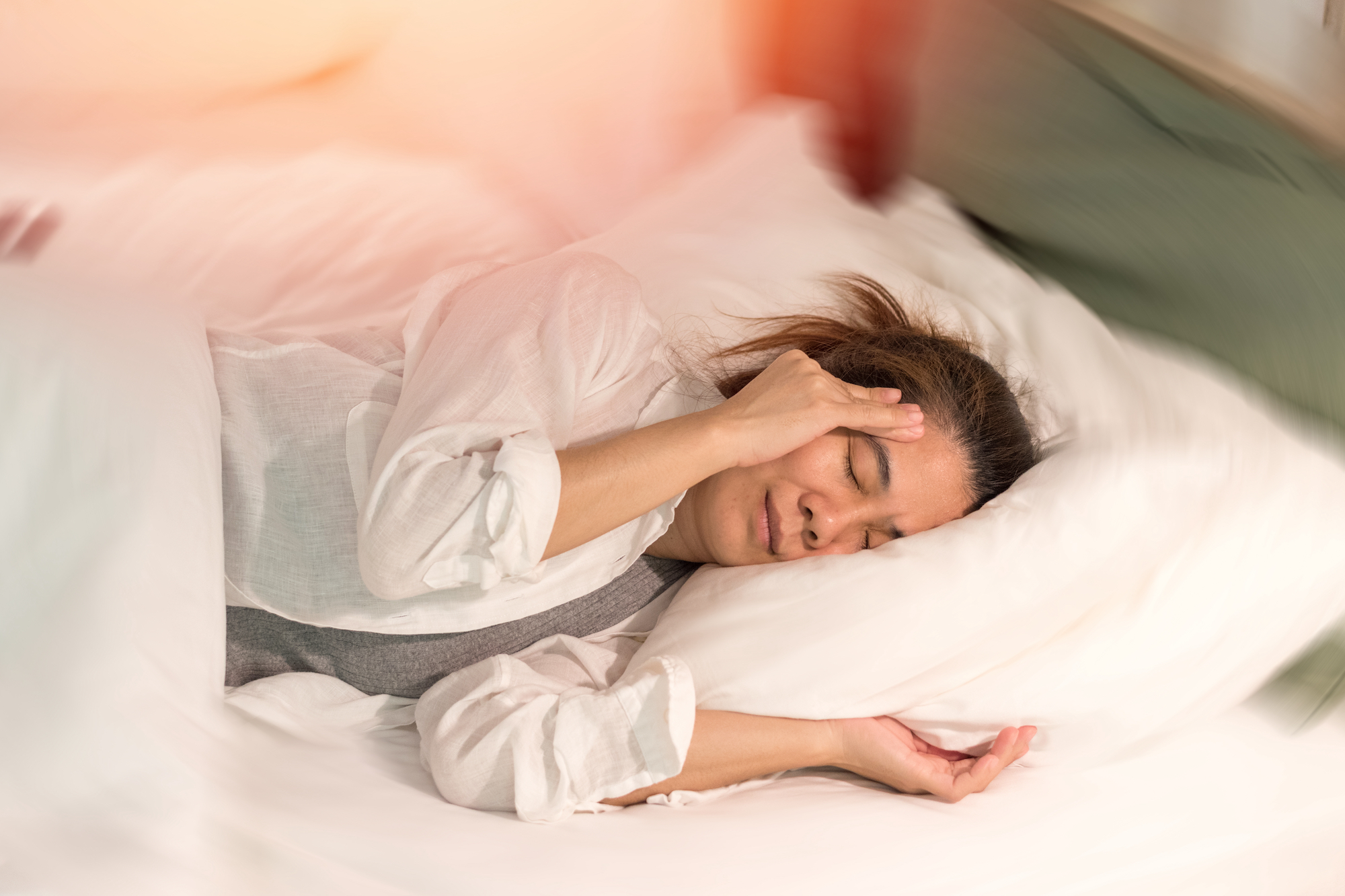How to Sleep Comfortably with BPPV: Expert Tips to Beat Nighttime Vertigo
To enhance sleep with Benign Paroxysmal Positional Vertigo (BPPV), it is essential to refrain from sleeping on the affected side and to keep the head elevated. Elevating the head a bit can assist in preventing the inner ear debris from inducing vertigo. Think about using an additional pillow or a wedge pillow to achieve the necessary elevation. Furthermore, moving slowly and cautiously when changing positions in bed can help reduce vertigo episodes.


Elaboration
Refrain from sleeping on the affected side:
BPPV is frequently triggered by alterations in head position, particularly when the affected ear is facing downward. Try out different positions to find which one is the most comfortable and the least likely to provoke vertigo.
Elevate your head:
Lifting the head a bit can help stop the tiny crystals in the inner ear from moving into the semicircular canals, which can cause vertigo. Utilizing an extra pillow or a wedge pillow can be beneficial.
Move cautiously:
When altering positions in bed, move cautiously and slowly to prevent abrupt movements that can lead to vertigo.
Explore other techniques:
Some people discover that deep breathing methods or meditation can assist them in falling asleep and staying asleep even with vertigo.
Seek advice from a healthcare professional:
If BPPV significantly affects the quality of sleep, it is vital to seek advice from a healthcare professional for further assessment and treatment possibilities.
Elevate the head: Resting with the head raised by a minimum of 45 degrees. View Source might assist in diminishing benign paroxysmal positional vertigo. Cushions can be utilized to support the upper back, neck, and head to reach this angle of elevation.
Getting a restful night’s sleep with vertigo can be difficult, but these helpful suggestions can assist you in resting more comfortably.
If Any Patient of ENT Requires Any Surgery, Opd Consultation Or Online Consultation In Clinic of ENT Specialist Doctor Dr. Sagar Rajkuwar ,He May Contact Him At The Following Address-
Prabha ENT Clinic, Plot no 345,Saigram Colony, Opposite Indoline Furniture Ambad Link Road ,Ambad ,1 km From Pathardi Phata Nashik ,422010 ,Maharashtra, India-Dr. Sagar Rajkuwar (MS-ENT), Cell No- 9892596635, 7387590194
Sleeping with vertigo can be difficult, as the sensations of dizziness and discomfort frequently make it challenging to relax. Nevertheless, insufficient sleep can also activate vertigo symptoms, leading to a cycle. This is the reason why acquiring quality sleep is essential to aid your recovery from vertigo.
Here are five useful tactics to help reduce vertigo at bedtime.
1. Maintain proper sleep hygiene
Setting a regular sleep pattern is vital for strengthening your body’s internal clock, especially if your sleep is often interrupted due to vertigo.


A 2023 research study focusing on balance disorders like vertigo revealed that half of their 137 participants indicated poor sleep quality. Those who had suffered from vertigo for 2 years or more experienced even greater sleep difficulties, including more trouble with both falling asleep and remaining asleep than those with shorter durations.
To enhance the quality of your sleep, consider participating in a soothing pre-sleep routine to assist in reducing anxiety levels, which can escalate when you are feeling dizzy. You could also experiment with gentle stretching or listening to calming music to help ease your mind and body.
Establishing a dark, quiet, and comfortable sleeping atmosphere might assist in reducing distractions.
2. Utilize supportive pillows and positioning
Sleeping with a supportive pillow aids in maintaining proper alignment of your head, neck, and spine, which is essential when dealing with spinning sensations and neck strain from vertigo.


Choose a back or side sleeping position with your head elevated to lessen the sensation of spinning. This positioning can enhance fluid dynamics in the inner ear, relieving vertigo symptoms and promoting rest.
A 2019 study examined the potential advantages of head-up sleep for 88 individuals suffering from challenging vertigo. The researchers proposed that keeping the head elevated may prevent tiny crystals in the inner ear from entering the semicircular canals, which can provoke vertigo.
For Update On Further Important Health Related Topics And Frequently Asked Questions On Health Topics By General Population Please Click On The Link Given Below To Join Our WhatsApp Group –
https://chat.whatsapp.com/Lv3NbcguOBS5ow6X9DpMMA
The findings revealed that those who engaged in head-up sleep reported reduced vertigo and faced fewer balance problems compared to the head-down group, with the beneficial effects lasting for up to 6 months.
3. Reduce screen time
Reducing screen time prior to sleep decreases blue light exposure, which may interfere with melatonin production and consequently impact your sleep.


A study investigated the effects of blue light exposure before bedtime on deep sleep and overall sleep quality. Eleven young males were subjected to three conditions for 1 hour before sleeping: incandescent light, blue light, and the use of blue light-blocking glasses.
The findings indicated that participants who were exposed to blue light experienced a considerably lower ratio of deep sleep in comparison to those exposed to incandescent light or wearing blue light-blocking glasses.
4. Utilize relaxation techniques
Incorporating relaxation techniques, like deep breathing and progressive muscle relaxation, can be helpful for individuals facing anxiety due to a health issue like vertigo. These practices encourage tranquility, decrease heart rates, and alleviate muscle tension that may exacerbate dizziness.


A study examined biofeedback therapy as a relaxation technique for those with vestibular disorders like vertigo. Biofeedback instructs users to regulate physiological functions by delivering real-time information on muscle tension and heart rate.
The research involved 197 outpatients. The control group received conventional treatment, which comprised monthly appointments with an ENT specialist and medications for vertigo. Conversely, the experimental group engaged in biofeedback training, receiving medication only at the beginning to stabilize their condition.
After three months, the experimental group displayed significant enhancements in overall dizziness, along with improvements in emotional, functional, and physical well-being. They also reported fewer stress-related symptoms compared to their initial conditions.
5. Remain hydrated
Maintaining hydration is essential for individuals experiencing vertigo, as it aids in sustaining inner ear function and fluid equilibrium, which lessens dizziness that can interfere with sleep. Sufficient hydration also enhances muscle performance and controls blood pressure, potentially preventing symptoms that disrupt a restorative night’s sleep.


Studies indicate that insufficient water consumption could be a risk factor for specific vestibular conditions, underlining the significance of adequate hydration and promoting higher water intake.
Furthermore, sufficient water consumption might reduce anxiety, leading to a more tranquil state and better sleep quality.
Tips for managing vertigo in the day
Here are several strategies for managing vertigo throughout the day:
- Avoid bright or flickering lights: Reduce exposure to intense lighting, which can exacerbate dizziness.
- Practice balance exercises: Participate in balance training or vestibular rehabilitation activities to enhance stability and coordination.
- Stay hydrated: Consume plenty of water to ensure fluid balance and support inner ear functionality.
- Avoid sudden movements: Move at a slow and deliberate pace to avoid triggering dizziness.
- Use stabilizing techniques: Concentrate on a fixed object to assist in regaining balance if you experience dizziness.
- Practice relaxation techniques: Engage in deep breathing or mindfulness activities to alleviate anxiety.
- Create a safe environment: Eliminate tripping hazards and utilize handrails to avert falls.
Another Choices for Vertigo
In many instances, vertigo can improve without any treatment. Nonetheless, if symptoms continue, a physician might suggest the following treatment alternatives:
Vestibular rehabilitation therapy (VRT): This specific type of physical therapy can assist in enhancing balance and minimizing dizziness.
Biofeedback therapy: This approach may aid individuals in gaining control over bodily functions, which could reduce symptoms.
Medications: Certain drugs, including antihistamines, benzodiazepines, and anticholinergics, may assist in managing symptoms as you recuperate.
Canalith repositioning maneuvers: Techniques such as the Epley maneuver, which shifts calcium particles in the inner ear, may aid with benign paroxysmal positional vertigo (BPPV).
FOR INFORMATION IN GREAT DETAIL ON Benign Paroxysmal Positional Vertigo (BPPV) Treatment PL CLICK ON THE LINK GIVEN BELOW-It Is Always Better To View Links From Laptop/Desktop Rather Than Mobile Phone As They May Not Be Seen From Mobile Phone. ,In Case Of Technical Difficulties You Need To Copy Paste This Link In Google Search. In Case If You Are Viewing This Blog From Mobile Phone You Need To Click On The Three Dots On The Right Upper Corner Of Your Mobile Screen And ENABLE DESKTOP VERSION.
FOR INFORMATION IN GREAT DETAIL ON Benign Paroxysmal Positional Vertigo (BPPV) Symptoms PL CLICK ON THE LINK GIVEN BELOW-It Is Always Better To View Links From Laptop/Desktop Rather Than Mobile Phone As They May Not Be Seen From Mobile Phone. ,In Case Of Technical Difficulties You Need To Copy Paste This Link In Google Search. In Case If You Are Viewing This Blog From Mobile Phone You Need To Click On The Three Dots On The Right Upper Corner Of Your Mobile Screen And ENABLE DESKTOP VERSION.
FOR INFORMATION IN GREAT DETAIL ON Benign Paroxysmal Positional Vertigo (BPPV) Causes PL CLICK ON THE LINK GIVEN BELOW-It Is Always Better To View Links From Laptop/Desktop Rather Than Mobile Phone As They May Not Be Seen From Mobile Phone. ,In Case Of Technical Difficulties You Need To Copy Paste This Link In Google Search. In Case If You Are Viewing This Blog From Mobile Phone You Need To Click On The Three Dots On The Right Upper Corner Of Your Mobile Screen And ENABLE DESKTOP VERSION.
FOR INFORMATION IN GREAT DETAIL ON Benign Paroxysmal Positional Vertigo (BPPV) Home Remedies PL CLICK ON THE LINK GIVEN BELOW-It Is Always Better To View Links From Laptop/Desktop Rather Than Mobile Phone As They May Not Be Seen From Mobile Phone. ,In Case Of Technical Difficulties You Need To Copy Paste This Link In Google Search. In Case If You Are Viewing This Blog From Mobile Phone You Need To Click On The Three Dots On The Right Upper Corner Of Your Mobile Screen And ENABLE DESKTOP VERSION.
FOR INFORMATION IN GREAT DETAIL ON How Do You Prevent BPPV Attacks? PL CLICK ON THE LINK GIVEN BELOW-It Is Always Better To View Links From Laptop/Desktop Rather Than Mobile Phone As They May Not Be Seen From Mobile Phone. ,In Case Of Technical Difficulties You Need To Copy Paste This Link In Google Search. In Case If You Are Viewing This Blog From Mobile Phone You Need To Click On The Three Dots On The Right Upper Corner Of Your Mobile Screen And ENABLE DESKTOP VERSION.
What causes benign paroxysmal positional vertigo (BPPV)?
A frequent inner ear ailment is benign paroxysmal positional vertigo (BPPV). Changes in your head position, such as sitting up in bed or tilting your head back, cause you to experience sudden vertigo (a sensation that the room is moving) if you have BPPV.
The onset of BPPV is not indicative of a significant underlying issue, and it often subsides on its own a few days after the initial episode. (In some people, it may take weeks.) Nevertheless, the symptoms of BPPV might be quite scary and perhaps harmful, particularly in people over 65. Falls, which are a major cause of fractures, can be brought on by the instability of BPPV.
Who is susceptible to benign paroxysmal positional vertigo?
Although anyone at any age can be impacted by BPPV, it is most prevalent among those over 50. In this age group, around half of all people have at least one episode of BPPV throughout their lives.
Although it’s uncommon, children can experience BPPV.
What is the prevalence of BPPV?
The most frequent inner ear condition is benign paroxysmal positional vertigo. Indeed, about 20% of those who are examined for dizziness are found to have BPPV.
Are the symptoms of BPPV persistent?
Normally, BPPV cures by itself. Until it is successfully treated, however, it may return. Sometimes, it may take months or even years for the next occurrence to take place.
Causes and Symptoms
The main symptom of BPPV is vertigo. The duration of this feeling of dizziness can range from a few seconds to a minute, and its severity can vary from moderate to extreme. It might be accompanied by additional symptoms of benign paroxysmal positional vertigo, such as:
- Dizziness.
- Lightheadedness.
- Issues with balance.
- Nausea and vomiting.
- Vision that is hazy.
- Nystagmus, or quick, uncontrolled eye movements.
Although BPPV usually only affects one ear at a time, it can potentially affect both.
What causes BPPV?
A shift in the position of your head is often the cause of BPPV. Symptoms can occasionally be felt when sitting up in bed or lying down. When tilting their head back or to the side, some people may experience symptoms. Normal wear and tear of the inner ear structures causes these symptoms to frequently worsen with age.
Sometimes, BPPV may be a sign of another illness in the inner ear, such as:
- Labyrinthitis.
- Vestibular neuritis.
- Neuroma of the ear.
Furthermore, BPPV can occur with migraines or manifest after a traumatic incident, such as a fall, accident, or sports-related injury.
What causes head posture changes to result in BPPV?
Calcium carbonate particles (otoconia) that have moved into your semicircular canals (inner ear structures that regulate balance) and become trapped cause BPPV. The otoconia are typically located in the utricle, a vestibular organ near your semicircular canals.
Due to injury, infection, or age, the otoconia in your utricle may become loose. The otoconia roll around and push on small hair-like structures (cilia) inside your semicircular canals as your head position changes. Your brain receives balance information through those cilia. The rolling otoconia stimulate the cilia, causing vertigo.
Tests and Diagnosis
BPPV may be identified during an office appointment with your healthcare provider. They’ll conduct a physical assessment and inquire about your symptoms and medical background.
Therapy and Management
Physical therapy exercises are the most successful way to treat benign paroxysmal positional vertigo. These exercises aim to relocate calcium carbonate particles from your semicircular canals into your utricle. The particles are simpler to absorb here, and they don’t induce any unpleasant symptoms.
Additionally, you may use anti-motion sickness medications to reduce your symptoms. But you shouldn’t use these drugs for a prolonged period of time.
The mechanism behind exercises for benign paroxysmal positional vertigo: How do they function?
The average duration of BPPV exercises, often known as canalith repositioning techniques, is around 15 minutes. Repositioning particles involves a succession of physical motions that alter the location of your head and body. These measures move the otoconia from your semicircular canals and back into their appropriate place in your utricle.
In around 80 to 90 percent of cases of BPPV, a single particle repositioning treatment is successful. If symptoms persist, additional BPPV exercises may be necessary.
This procedure can be carried out by your healthcare professional during an office appointment. Additionally, they can show you how to perform these exercises at home in order to alleviate your BPPV symptoms.
In the meanwhile, try these steps:
- Step 1: Begin by sitting up on a bed or table. Turn your head 45 degrees towards the ear that is causing you trouble.
- Step 2: Lie down with your head somewhat over the edge of the bed or table, making sure your head is facing the afflicted ear. Wait a minute or until your symptoms subside.
- Step 3: Turn your head quickly in the other direction, keeping your head down, until your “good” ear is parallel with—but just beyond the edge of—the bed or table. Wait till your symptoms subside—around a minute.
- Step 4: Turn onto your side. Turn your head another 90 degrees in the same direction as in step 3, so that your nose is now facing the floor. Give it a minute.
- Step 5: Sit up in the direction your body is facing, with your chin tucked in towards your shoulder. Follow any post-particle repositioning advice provided to you by your healthcare practitioner.
If I have benign paroxysmal positional vertigo, what may I anticipate?
The positive aspect of BPPV is that it does not point to a significant medical issue. However, managing your symptoms might be frightening and aggravating. Your healthcare provider can show you how to perform BPPV exercises at home so you may control your symptoms as soon as you experience any issues.
How long does BPPV persist?
An episode of BPPV typically lasts one to two minutes. Depending on the severity of your symptoms, you may experience nausea and vomiting. When you attempt to stand or walk, you may even lose your balance.
What strategies can I use to lower my chance of getting BPPV?
Although you can’t avoid BPPV, you can control it using particle repositioning techniques. Be sure to wear a helmet while cycling, engaging in contact sports, or engaging in other comparable activities in order to lessen your chance of experiencing trauma-related BPPV.
At what time should I consult my healthcare provider?
Make an appointment with your healthcare professional if you have had a BPPV episode. To help alleviate your symptoms, they may show you actual physical therapy exercises.
Call 911 immediately if you experience chest pain, an erratic heartbeat, or a severe headache in addition to your dizziness.
If Any Patient of ENT Requires Any Surgery, Opd Consultation Or Online Consultation In Clinic of ENT Specialist Doctor Dr. Sagar Rajkuwar ,He May Contact Him At The Following Address-
Prabha ENT Clinic, Plot no 345,Saigram Colony, Opposite Indoline Furniture Ambad Link Road ,Ambad ,1 km From Pathardi Phata Nashik ,422010 ,Maharashtra, India-Dr. Sagar Rajkuwar (MS-ENT), Cell No- 7387590194, 9892596635
Issued In Public Interest By –
www.entspecialistinnashik.com



